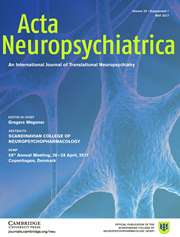Crossref Citations
This article has been cited by the following publications. This list is generated based on data provided by
Crossref.
Nanke, Alexandra
and
Rief, Winfried
2004.
Biofeedback in somatoform disorders and related syndromes.
Current Opinion in Psychiatry,
Vol. 17,
Issue. 2,
p.
133.
Sumathipala, Athula
2007.
What is the Evidence for the Efficacy of Treatments for Somatoform Disorders? A Critical Review of Previous Intervention Studies.
Psychosomatic Medicine,
Vol. 69,
Issue. 9,
p.
889.
Weise, Cornelia
Heinecke, Kristin
and
Rief, Winfried
2007.
Biofeedback bei chronischem Tinnitus – Behandlungsleitfaden und vorläufige Ergebnisse zu Wirksamkeit und Akzeptanz.
Verhaltenstherapie,
Vol. 17,
Issue. 4,
p.
220.
Henningsen, Peter
and
Martin, Alexandra
2008.
Störungsorientierte Psychotherapie.
p.
541.
Mewes, Ricarda
and
Rief, Winfried
2008.
Somatoforme Störungen und Hypochondrie.
Psychiatrie und Psychotherapie up2date,
Vol. 2,
Issue. 03,
p.
189.
Sumathipala, Athula
2009.
Somatic Presentations of Mental Disorders: Refining the Research Agenda for DSM-V.
p.
103.
Rief, Winfried
and
Arolt, Volker
2009.
Therapie psychischer Erkrankungen.
p.
267.
Sumathipala, Athula
2010.
Manifestaciones Somáticas de los Trastornos Mentales.
p.
97.
Creed, Francis
van der Feltz-Cornelis, Christina
Guthrie, Else
Henningsen, Peter
Rief, Winfried
Schröder, Andreas
and
White, Peter
2011.
Medically Unexplained Symptoms, Somatisation and Bodily Distress.
p.
175.
Kleinstäuber, Maria
Witthöft, Michael
and
Hiller, Wolfgang
2011.
Efficacy of short-term psychotherapy for multiple medically unexplained physical symptoms: A meta-analysis.
Clinical Psychology Review,
Vol. 31,
Issue. 1,
p.
146.
박문규
and
ChongNak Son
2011.
Cognitive Biases, Decreased Attention and Memory in Somatization Groups.
Korean Journal of Health Psychology,
Vol. 16,
Issue. 3,
p.
623.
Gottschalk, J.M.
and
Rief, W.
2012.
Psychotherapeutische Ansätze für Patienten mit somatoformen Störungen.
Der Nervenarzt,
Vol. 83,
Issue. 9,
p.
1115.
Douzenis, Athanassios
and
Seretis, Dionysis
2013.
Descriptive and predictive validity of somatic attributions in patients with somatoform disorders: A systematic review of quantitative research.
Journal of Psychosomatic Research,
Vol. 75,
Issue. 3,
p.
199.
van Dessel, Nikki
den Boeft, Madelon
van der Wouden, Johannes C
Kleinstäuber, Maria
Leone, Stephanie S
Terluin, Berend
Numans, Mattijs E
van der Horst, Henriëtte E
and
van Marwijk, Harm
2014.
Non-pharmacological interventions for somatoform disorders and medically unexplained physical symptoms (MUPS) in adults.
Cochrane Database of Systematic Reviews,
Vol. 2014,
Issue. 11,
Van Dessel, Nikki
Den Boeft, Madelon
van der Wouden, Johannes C
Kleinstäuber, Maria
Leone, Stephanie S
Terluin, Berend
Numans, Mattijs E
van der Horst, Henriëtte E
van Marwijk, Harm
and
Van Dessel, Nikki
2014.
Cochrane Database of Systematic Reviews.
Martlew, Jayne
Pulman, Jennifer
and
Marson, Anthony G
2014.
Psychological and behavioural treatments for adults with non-epileptic attack disorder.
Cochrane Database of Systematic Reviews,
Vol. 2014,
Issue. 2,
Koelen, Jurrijn A.
Houtveen, Jan H.
Abbass, Allan
Luyten, Patrick
Eurelings-Bontekoe, Elisabeth H. M.
Van Broeckhuysen-Kloth, Saskia A. M.
Bühring, Martina E. F.
and
Geenen, Rinie
2014.
Effectiveness of psychotherapy for severe somatoform disorder: meta-analysis.
British Journal of Psychiatry,
Vol. 204,
Issue. 1,
p.
12.
2014.
Therapie Psychischer Erkrankungen.
p.
1.
2015.
Therapie Psychischer Erkrankungen.
p.
e1.
Panebianco, Mariangela
Sridharan, Kalpana
Ramaratnam, Sridharan
and
Panebianco, Mariangela
2015.
Cochrane Database of Systematic Reviews.

